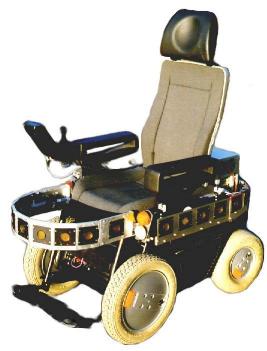
"Rolland" - The Bremen Autonomous Wheelchair
 Safety in Cognitive Robotics and Behaviour-Based Navigation
Safety in Cognitive Robotics and Behaviour-Based Navigation
Headed by Professor Dr. Bernd Krieg-Brückner, the group "Cognitive Robotics" of the Bremen Institute of Safe Systems at the University of Bremen is developing an intelligent means of transport for elder and handicapped persons - the Bremen Autonomous Wheelchair "Rolland". The power wheelchair Meyra Genius 1.522 is equipped with sensors and a PC. It is both, a scientific platform for experiments within the priority program "Spatial Cognition" of the Deutsche Forschungsgemeinschaft (DFG) as well as a demonstrator for the use of formal methods in the development of safety-critical embedded systems.
The research with respect to spatial cognition focusses on navigation. On one hand, experiences from psychology and (neuro-)biology are used, on the other hand, open questions in these fields are to be answered by the technical realisation on a robot. The latter is especially interesting for cognitive psychology, because it is pretty easy to determine the a-priori knowledge of a robot-proband - in contrast to the one of animals or persons. In addition to the theoretical examination of the basics of navigation, robust techniques are developed which enable the wheelchair to learn even complex behaviours by combining several elementary behaviours such as wall-following or doorway-passage. The navigation approaches implemented are based on the optical recognition of routemarks (natural or artificial points of reference): Significant objects in the environment are (re-)cognized with a video camera.
The Bremen Autonomous Wheelchair is used as an example for the developement of safe systems with the help of formal methods because of the high relevance of safety aspects in the field of rehabilitation robotics. In contrast to classical industrial robotics, people live in the immediate vicinity and often also in a direct dependence on a rehabilitation robot as Rolland. Therefore, such systems must be devoloped safely with respect to collision freeness and following the user's commands. With the help of a hazard analysis, safety requirements were defined. From this specification, a safety module was developed that was partially verified. It is the interface between the application to be developed and the safe wheelchair.
As first application, a driving assistent was implemented that adapts the speed ordered by the user via the joystick to the current obstacle situation. Thus the wheelchair gradually slows down when approaching an obstacle. In addition, the driving assistent supports the user by passing door-frames and by turning round. In the next development step, the wheelchair will be enhanced - among other things - by a speech input control interface.
For further information, please click here.
Author: Dr. Thomas Röfer
| Last updated: March 7, 2002 |